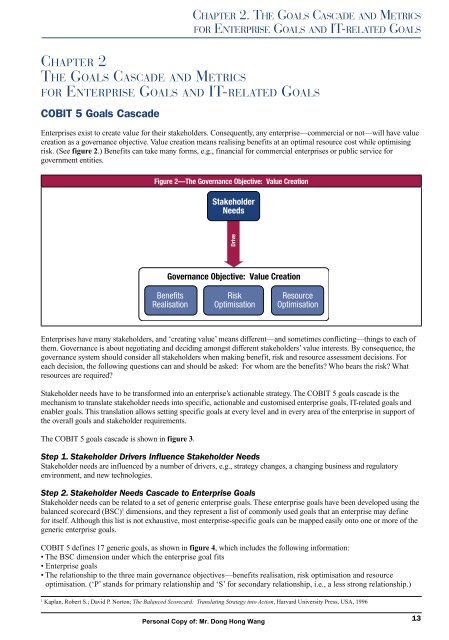Enabling Processes
Enabling Processes
Enabling Processes
Create successful ePaper yourself
Turn your PDF publications into a flip-book with our unique Google optimized e-Paper software.
CHAPTER 2. THE GOALS CASCADE AND METRICS<br />
FOR ENTERPRISE GOALS AND IT-RELATED GOALS<br />
CHAPTER 2<br />
THE GOALS CASCADE AND METRICS<br />
FOR ENTERPRISE GOALS AND IT-RELATED GOALS<br />
COBIT 5 Goals Cascade<br />
Enterprises exist to create value for their stakeholders. Consequently, any enterprise—commercial or not—will have value<br />
creation as a governance objective. Value creation means realising benefits at an optimal resource cost while optimising<br />
risk. (See figure 2.) Benefits can take many forms, e.g., financial for commercial enterprises or public service for<br />
government entities.<br />
Figure 2—The Governance Objective: Value Creation<br />
Benefits<br />
Realisation<br />
Enterprises have many stakeholders, and ‘creating value’ means different—and sometimes conflicting—things to each of<br />
them. Governance is about negotiating and deciding amongst different stakeholders’ value interests. By consequence, the<br />
governance system should consider all stakeholders when making benefit, risk and resource assessment decisions. For<br />
each decision, the following questions can and should be asked: For whom are the benefits? Who bears the risk? What<br />
resources are required?<br />
Stakeholder needs have to be transformed into an enterprise’s actionable strategy. The COBIT 5 goals cascade is the<br />
mechanism to translate stakeholder needs into specific, actionable and customised enterprise goals, IT-related goals and<br />
enabler goals. This translation allows setting specific goals at every level and in every area of the enterprise in support of<br />
the overall goals and stakeholder requirements.<br />
The COBIT 5 goals cascade is shown in figure 3.<br />
Stakeholder<br />
Needs<br />
Governance Objective: Value Creation<br />
Risk<br />
Optimisation<br />
Resource<br />
Optimisation<br />
Step 1. Stakeholder Drivers Influence Stakeholder Needs<br />
Stakeholder needs are influenced by a number of drivers, e.g., strategy changes, a changing business and regulatory<br />
environment, and new technologies.<br />
Step 2. Stakeholder Needs Cascade to Enterprise Goals<br />
Stakeholder needs can be related to a set of generic enterprise goals. These enterprise goals have been developed using the<br />
balanced scorecard (BSC) 1 dimensions, and they represent a list of commonly used goals that an enterprise may define<br />
for itself. Although this list is not exhaustive, most enterprise-specific goals can be mapped easily onto one or more of the<br />
generic enterprise goals.<br />
COBIT 5 defines 17 generic goals, as shown in figure 4, which includes the following information:<br />
� ��� ��� ��������� ����� ����� ��� ���������� ���� ����<br />
� ���������� �����<br />
� ��� ������������ �� ��� ����� ���� ���������� ������������������� ������������ ���� ������������ ��� ��������<br />
optimisation. (‘P’ stands for primary relationship and ‘S’ for secondary relationship, i.e., a less strong relationship.)<br />
1 Kaplan, Robert S.; David P. Norton; The Balanced Scorecard: Translating Strategy into Action, Harvard University Press, USA, 1996<br />
Drive<br />
Personal Copy of: Mr. Dong Hong Wang<br />
13


